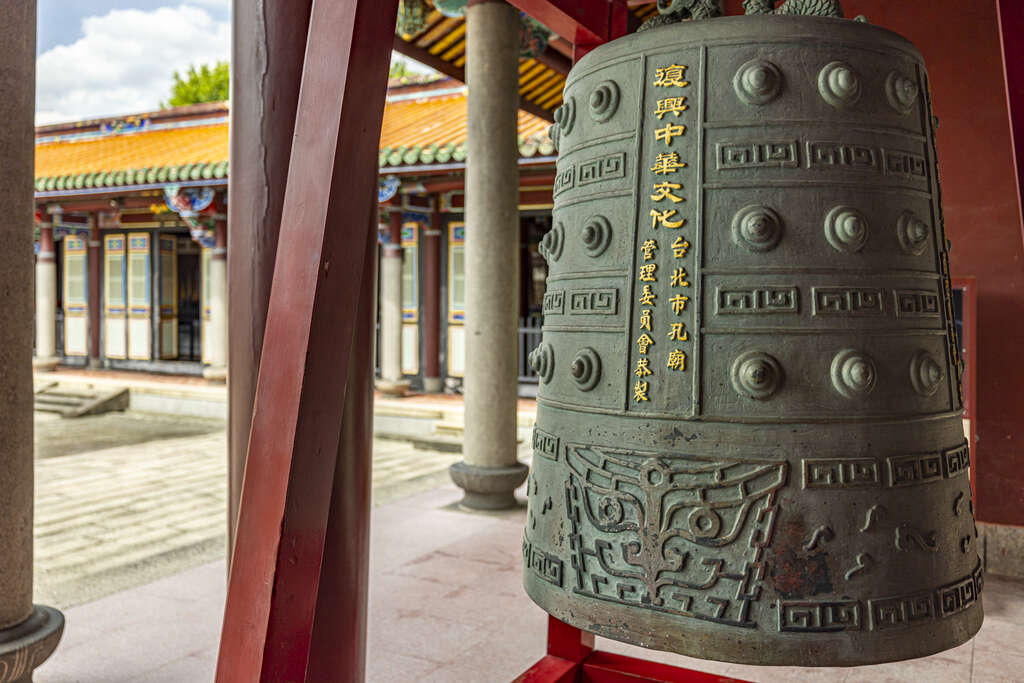Taipei Confucius Temple Introduction
The Taipei Confucius Temple was constructed in 1927, located in the historically rich Dalongdong Old Street. Under the urban renewal plans promoted by the Taipei City Government, it forms the Dalongdong Cultural Park along with Dalong Elementary School and Bao'an Temple, signifying a "temple, school, and shrine" cultural area, serving multiples meanings as a ceremonial site, a symbol of Confucianism, and a designated historic site. The design of the Taipei Confucius Temple follows the architectural style of the original temple in Qufu, featuring unadorned beams and columns, which exude simplicity and solemnity. Its layout includes the Wànrèn Palace Wall, the Pàn Pool, the Lingxing Gate, the Ceremony Gate, the Dacheng Hall, and the Chongsheng Ancestral Hall. Notably, all pillars, doors, and windows in the temple lack couplets, symbolizing that no one dares to flaunt their literary skills before the revered sage Confucius. Constructed by the community, the temple also reflects regional decorative styles, incorporating the unique Minnan-style decorative techniques of Jiaozi pottery and paper-cutting, especially the Jiaozi pottery decorations, which are relatively unique among Confucius Temple buildings in Taiwan. The main hall, the Dacheng Hall, enshrines the tablet of the Most Holy Sage Confucius in a central shrine, with a prominent black plaque inscribed with "Educate Without Distinction" hanging above. The walls on either side honor the Four Supporting Scholars (the Reviver Yan, the Ancestor Zeng, the Teacher Zisi, and the Sub-Sage Mencius) along with the 12 Philosophers, creating an atmosphere of solemnity and reverence. The Confucius Temple radiates a sense of respectful grandeur, reflecting the upright spirit of Chinese Confucian culture. The richly decorated Jiaozi pottery water wheel ornament in the Dacheng Hall is a distinctive feature of Taiwan's Confucius Temple architecture, deserving close appreciation for its aesthetic beauty. Although the temple does not house numerous deities or ritual implements, it possesses many ceremonial vessels and musical instruments according to ancient traditions. Each year, during the September 28th Sacrificial Ceremony, music and dance are performed alongside offerings of animals and wine to express reverence for Confucius, attracting many visitors from both domestically and abroad, allowing them to experience the solemn atmosphere of traditional Chinese sacrificial rites. In recent years, the Confucius Temple has actively revitalized the historic site by establishing exhibition rooms for cultural artifacts and multimedia showcases, providing insights into the beauty of the temple as well as the ceremonial vessels and instruments used in sacrificial observances. A unique display center for the Bayin musical instruments allows visitors to hear the diverse sounds of these instruments simply by pressing on the illustrations, offering insight into the music of the Bayin. Additionally, the temple has implemented a comprehensive multilingual guide system in Mandarin, English, Japanese, and Korean to serve international tourists. Furthermore, the temple frequently hosts various innovative activities combining traditional and modern art, with the annual Dalongdong Cultural Season series offering experiences of sacrificial culture and enhancing understanding of Confucianism, bringing in a new wave of visitors. Moreover, a 4D virtual reality theater has been set up in the Minglun Hall, using high-tech imagery and immersive effects to narrate the history of the temple and the life story of Confucius, allowing audiences to understand the stories related to Confucius and the temple. This not only adds an element of fun but also continues the educational significance represented by the Confucius Temple in a novel way.
































